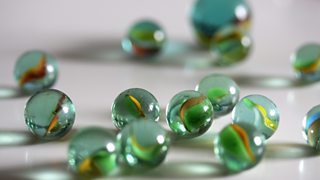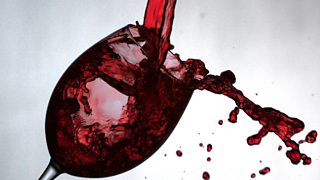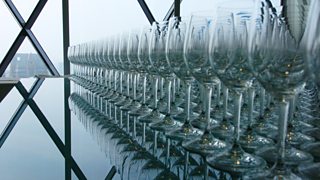10 wondrous facts about the wine glass
There are a huge variety of implements from which to quaff a claret – big ones, small ones, tumblers, flutes, coupes – but do they really make a difference to how our wine tastes? And how did we get from the dinky Georgian vessel the size of a shot glass to the modern-day gargantuan goblet?
Here are ten wondrous facts about the history of the wine glass and its role today, from The Origin of Stuff. Bottoms up!

-
![]()
The Origin of Stuff: Wine Glass
Katy Brand toasts the wine glass and delves into its origins.
1. The wine glass emerged out of medieval Venice
The modern-day glass as we know it probably emerged around 1400 in the city of Venice.
People have been using glass to drink wine for a lot longer, even in the ancient world, but the design we think of – essentially a bowl, a stem and a base – is medieval.
Back then, Venice was the centre of the glassblowing world. The Venetians had learnt how to purify their alkaline source which meant that they could make “cristallo” – a very sought-after form of clear glass.
2. The stem may have originated on religious vessels
Where did the stem come from? Probably the church.
Are wines with award stickers actually any better?

What is the judging criteria for these award-winning wines?
The stem already existed on cups made out of metal that were used for holy communion. The stem would have allowed the priest to more easily lift the chalice up to the congregation for all to see.
3. Early wine glasses got “glass disease”
When the Venetian glassmakers began to purify their raw materials to remove elements that were causing colour, they inadvertently removed some of the things that were making the glass durable, like lime, which acted as a stabiliser.

This meant that the original clear glasses could start to deteriorate quite quickly in normal air.
The symptoms of glass disease were initially “weeping”, when moisture caused alkali to be leached out of the glass, and “crizzling”, a series of very fine cracks caused by the loss of alkali that eventually caused the glass to fall apart.
4. The English discovered the secret to stronger glass
In the 1600s the English began to follow in the footsteps of the Venetians and create their own glass industry.
A crucial moment in the development of glass came when the Royal Navy asked glassmakers to stop cutting down oak trees to fuel their fires. They were depleting fast and still needed for ship building.
So English glassmakers turned to sea-coal. This burned to much higher temperatures, creating hotter furnaces, which immediately strengthened the glass. (This stronger glass also produced stronger bottles, which played a crucial role in the birth of champagne. Fermenting wine was shattering French bottles all over the shop but the English starting re-bottling their imported French wine and fizzy wine could begin to be celebrated.)
The atomic structure of glass explained

All you need is some marbles, a biscuit tin and Paul McMillan, a Professor of Chemistry at UCL.
5. An Englishman is behind the sparkle
In the 1670s George Ravenscroft was put in charge of trying to make glass better and more beautiful.
He added lead oxide and flint to the mix, which made glass even stronger still, and gave it the ability to look almost like crystal.
Lead oxide makes glass sparkle because it effects how the light passes through – it causes the different colours in light to travel at different speeds, a process known as dispersion. It also fluoresces slightly in the UV.
6. In the early 18th century, you weren’t in charge of your own glass
In the early 1700s the wine glass was kept away from the drinker. You glass would have been brought to you by your footman or your valet, who would also fill it up for you. You’d then glug down its contents and hand it back to them.
But through the late 1700s and into the 1800s, the wine bottle moved to the dinner table, and so did the glass.
Finally, the ability to top oneself up!
Do you have what it takes to be a wine master?

What it takes to head up the world's most prestigious wine organisation.
7. Stems had a practical as well as aesthetic purpose
With glasses on the table there was a desire for more elegant, sophisticated models.
Wine glasses got taller and more elegant, and stems got longer, with twists and little bulges called “knops”. But the aesthetically pleasing stem had a practical purpose too.
Wines should be served at the correct temperature but they can easily grow too warm with a big fist around the bowl.
Not only did holding a glass by the stem look effete and elegant, it also helped wine to remain at its peak optimum temperature.
How rosé wines are becoming classier

The evidence that the quality of rosé is improving, with prices to match.
8. Originally, a wine glass was more like a shot glass
A little Georgian glass from 1700 is perhaps seven times smaller than the glass you’d be handed in a pub today if you asked for a large red wine.
A little Georgian glass from 1700 is perhaps seven times smaller than the glass you’d be handed in a pub today if you asked for a large red wine.
An obvious reason as to why they started small was the tax on glass that existed for around a hundred years from the 1700s to the mid 1800s. When that financial pressure was removed, the wine glass grew.
Industrialisation also meant we could make larger ones that were standardised in shape and form.
9. A Champagne glass used to be wide and flat
We used to drink champagne out of the couple glass but it soon became apparent that the wide brim and large surface released too many bubbles too quickly, causing the fizz to go flat. So then came the tulip-shaped flute that we know and love.

The small rim slows the dissipation of those CO2 bubbles, and the tall shape shows them off as they rise. Beautiful!
However, the narrow rim also means a build-up of CO2 in our headspace, which actually enhances sourness.
Nowadays, when wine buffs have the annual champagne tasting in London, the professionals will reach for an ordinary white wine glass to host their tipple. (The added benefit of course being you can get more in.)
10. The shape of the glass affects how we taste wine
We’ve all seen people sticking their whole nose inside a fishbowl-sized glass, which holds just a tiny puddle of red wine at the bottom. But is the big claret balloon actually helpful?
The truth is that the shape of the glass will affect how much wine gets into our mouth, whether it travels across the tongue to the back or spreads to the sides. So different glasses can make the same wine taste different.
With a wide bowl you are also increasing the surface area of the wine and that’s increasing its contact with oxygen, which will release more of the volatiles.
Getting your nose right in there means those aromas are funnelled into your nose and not your neighbours, and that you’re still saturated with them when you take your first mouthful. This all adds to the tasting experience.
Wine in a can: the perfect beverage for a festival?

We all know wine in boxes. But what about buying it in cans?
More from Radio 4
-
![]()
The Origin of Stuff: Wine Glass
Katy Brand toasts the wine glass and delves into its origins from a dinky little thing to the gargantuan glass it is today.
-
![]()
A Five-step Guide to Becoming a Wine Bluff...
Many of us don't know our Grenache from our Gewürztraminer: here's how to avoid the shame.
-
![]()
Cava chameleon: Six sparkling wines well worth knowing?
Sparkling wine doesn’t have to mean cork-poppingly expensive Champagne.
-
![]()
Why your wine might be made in China
China is now a leading international wine producer, so why does only one major UK supermarket stock it?




